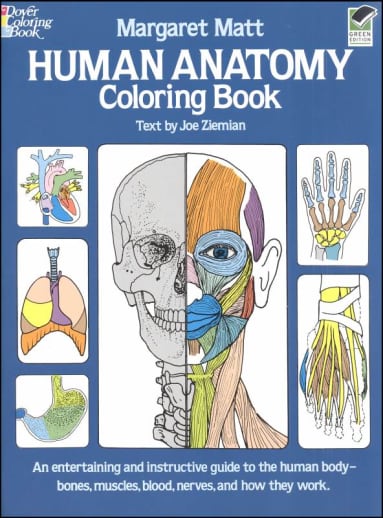Coloring books help you to concentrate on a subject. This Dover book contains scientifically accurate renderings of the body organs and major systems for you to color while you study. It has a surprising amount of detail for an inexpensive book. Divided into 11 different sections, it covers all major body systems. Diagrams of systems are divided into numbered sections like color-by-number pictures. A chart lists the name of each body part and what color to use. A good, low-cost starter on anatomy.
Human Anatomy Coloring Book
Description
An affordable anatomy class, this easy learning study aid contains careful, scientifically accurate line renderings of the body's organs and major systems: skeletal, muscular, nervous, digestive, reproductive, and more. A total of 43 coloring pages (often with several illustrations on each) offers numerous views, cross-sections, diagrams and detailed closeups, labelled and numbered to correspond with suggestions for coloring. These suggestions are specially designed to emphasize the structural relationship in the body. By working through each system, the reader will gain not only an intimate knowledge of the location, appearance and role of the body parts, this learning tool will also be laying the groundwork for more sophisticated studies of anatomy.
These high-quality, informative coloring books are just right for accompanying a unit study. Subjects are nicely detailed. Generally, illustrations on the inside covers depict the natural colors if you want to produce a realistic finished product. Very brief captions are nonetheless instructive. After coloring through a book, we're certain you'll be able to more easily identify specimens when you see them. Some books, like Rocks and Minerals, have several pages of worthwhile information in the front, including a discussion of different types of rocks and minerals, how to start collecting rocks, classifying rocks, and specific tests for identifying them. The My Horse coloring book has an introductory four pages on horse anatomy and features, then contains generous captions that form a mini-course in identifying, classifying, riding, and caring for horses. Our favorite medium is colored pencil. Since we offer a selection of quality colored pencils, we thought we'd lay in a generous supply of our favorite educational coloring books as well!
Boost™ editions, subtitled "seriously fun learning," are aligned to the Common Core with specific standardsnoted at the bottom of each page. A freeteacher's manual can be downloaded from theDover website.
| Product Format: | Softcover Book |
|---|---|
| Grades: | 4-AD |
| Brand: | Dover Publications |
| Author: | Margaret Matt |
| ISBN: | 9780486241388 |
| EAN/UPC: | 800759241385 |
| Length in Inches: | 11 |
| Width in Inches: | 8.25 |
| Height in Inches: | 0.25 |
| Weight in Pounds: | 0.4 |
| Ages: | 10 - 13 |
| Edition: | Illustrated |
| Pages: | 48 |
| Publication Date: | 2/1/1982 |

